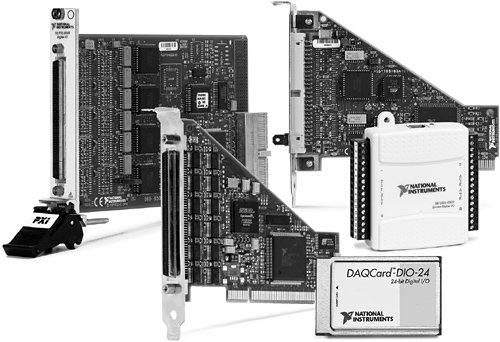What Is Data Acquisition?
| Data acquisition, or DAQ for short, is simply the process of measuring a real-world signal, such as a voltage, and bringing that information into the computer for processing, analysis, storage, or other data manipulation. Figure 2.1 shows the components of a DAQ system. Physical phenomena (which are not shown in Figure 2.1) represent the real-world signals you are trying to measure, such as speed, temperature, humidity, pressure, flow, pH, start-stop, radioactivity, light intensity, and so on. You use sensors (sometimes also called transducers) to evaluate the physical phenomena and produce electrical signals proportionately. For example, thermocouples, a type of sensor, convert temperature into a voltage that an A/D (analog to digital) converter can measure. Other examples of sensors include strain gauges, flowmeters, and pressure transducers, which measure displacement in a material due to stress, rate of flow, and pressure, respectively. In each case, the electrical signal produced by the sensor is directly related to the phenomenon it monitors. Figure 2.1. DAQ system LabVIEW can command DAQ devices to read analog input signals (A/D conversion), generate analog output signals (D/A conversion), read and write digital signals, and manipulate the on-board counters for frequency measurement, pulse generation, quadrature encoder measurements, and so on, to interface with the transducers. In the case of analog input, the voltage data from the sensor goes into the plug-in DAQ devices in the computer, which sends the data into computer memory for storage, processing, or other manipulation. Signal conditioning modules "condition" the electrical signals generated by transducers so that they are in a form that the DAQ devices can accept. For example, you would want to isolate a high-voltage input such as 120 VAC, lest you fry both your board and your computera costly mistake! Signal conditioning modules can apply to many different types of conditioning: amplification, linearization, filtering, isolation, and so on. Not all applications will require signal conditioning, but many do, and you should pay attention to your specifications to avoid a potential disaster. In addition, information loss can be even worse than equipment loss! Noise, nonlinearity, overload, aliasing, etc. can hopelessly corrupt your data, and LabVIEW will not save you. Signal conditioning is often not optionalit's best to check before you start. Figure 2.2. Many types of DAQ devices are available from NI. To acquire data in your lab using the virtual instrumentation approach, you will need a DAQ device, a computer configured with LabVIEW and DAQ driver software, and some method of connecting your transducer signal to the DAQ device, such as a connector block, breadboard, cable, or wire. You may also need signal conditioning equipment, depending on the specifications of your application. For example, if you wanted to measure a temperature, you would need to wire the temperature sensor to an analog input channel on the DAQ device in your computer (often via signal conditioning equipment, depending on the sensor). Then use LabVIEW's DAQ VIs to read the channel on the board, display the temperature on the screen, record it in a data file, and analyze it any way you need to.
The built-in LabVIEW data acquisition VIs only work with National Instruments' DAQ devices. If you are using a board from another vendor, you will have to get a driver from them (if they have one), or you will have to write your own driver code and call it from LabVIEW using code interface nodes or dynamic link libraries. |
EAN: 2147483647
Pages: 294


